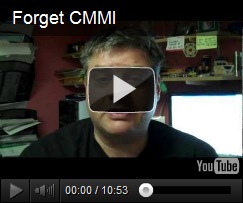Why Do You Want to Be There?
This year, the conference is significantly re-orienting itself towards END USERS. Previous SEPG conferences had a lot of useful information, especially for experienced change agents and consultants in the field.
This year, the focus is on up-and-coming disciplines, established success strategies, and most importantly, direct business performance benefit of using CMMI. In fact, what we’ve seen over the years is that CMMI is working extremely well with other forms of improvement as well as with existing defined service delivery and product development approaches — whether agile, lean, traditional, customer-focused, innovation-focused, or some combination.
CMMI provides a specific framework that is both a way to focus attention on specific needs while also benchmarking progress. Instead of flailing around trying to find where to put improvement energies, or waiting for a long-term traditional approach of process exploration and decomposition, CMMI takes a lot of the guesswork out by leveraging decades of experience and laying out very specific goals to seek to improve performance.
CMMI users have reported their productivity to increase magnitudes of order, costs drop in double digits, and their ability to cut through thick process jungles more quickly than being left alone to their own devices.
Yes, I’m speaking and presenting at SEPG 2013, but that’s the least relevant reason to attend. Come because you want to see what others are doing to marry CMMI with existing (or new to you) concepts; come because you want to hear from other end-users what they’re doing with CMMI to improve performance. And, most of all, come because you want to get and stay ahead of your competitors who aren’t using CMMI nearly as effectively as you will after attending.
SEPG North America: The CMMI Conference is coming soon, but there is still time to register.
This year’s conference program will include content perfect for you if you are:
- Beginning to implement–or considering implementation of—CMMI
- Seeking resources and best practices for integrating CMMI and Agile practices
- Interested in taking your process improvement game up a level
- A fan of rivers, boats, bridges or baseball !
Check out the conference agenda here: http://sepgconference.org/sepg-north-america-agenda and when you register, enter the promotional code "Entinex" to save $100 on your fee. (Or just click this link and the discount will be applied for you.)
Book before September 1st to get a discount on your hotel room, as well.
Get the details on the website (http://sepgconference.org) and email sepg@cmmiinstitute.com with any questions.




